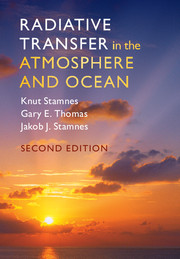Book contents
- Frontmatter
- Contents
- List of Illustrations
- List of Tables
- 1 Basic Properties of Radiation, Atmospheres, and Oceans
- 2 Basic State Variables and the Radiative Transfer Equation
- 3 Basic Scattering Processes
- 4 Absorption by Solid, Aqueous, and Gaseous Media
- 5 Principles of Radiative Transfer
- 6 Formulation of Radiative Transfer Problems
- 7 Approximate Solutions of Prototype Problems
- 8 The Role of Radiation in Climate
- 9 Accurate Numerical Solutions of Prototype Problems
- 10 Shortwave Radiative Transfer in the Atmosphere and Ocean
- Appendix A Nomenclature: Glossary of Symbols
- Appendix B Physical Constants
- Appendix C Ocean Optics Nomenclature
- Appendix D Reflectance and Transmittance at an Interface
- References
- Index
3 - Basic Scattering Processes
Published online by Cambridge University Press: 13 July 2017
- Frontmatter
- Contents
- List of Illustrations
- List of Tables
- 1 Basic Properties of Radiation, Atmospheres, and Oceans
- 2 Basic State Variables and the Radiative Transfer Equation
- 3 Basic Scattering Processes
- 4 Absorption by Solid, Aqueous, and Gaseous Media
- 5 Principles of Radiative Transfer
- 6 Formulation of Radiative Transfer Problems
- 7 Approximate Solutions of Prototype Problems
- 8 The Role of Radiation in Climate
- 9 Accurate Numerical Solutions of Prototype Problems
- 10 Shortwave Radiative Transfer in the Atmosphere and Ocean
- Appendix A Nomenclature: Glossary of Symbols
- Appendix B Physical Constants
- Appendix C Ocean Optics Nomenclature
- Appendix D Reflectance and Transmittance at an Interface
- References
- Index
Summary
Introduction
In the next two chapters, we will study the physical basis for the three types of light-matter interactions which are important in planetary media – scattering, absorption, and emission. In this chapter, we concentrate on scattering, which may be thought of as the “first step” in both the emission and absorption processes. The classical concept of the Lorentz atom is first used to visualize the process of scattering, which encompasses both coherent processes, such as refraction and reflection, as well as the many incoherent processes which are the main topic of this chapter.
Consideration of the classical interaction of a plane wave with an isolated, damped, simple harmonic oscillator helps to introduce the concept of the cross section. The scattering cross section is expressed in terms of the frequency of the incident light, the natural frequency of the oscillator, and the damping rate. A simple extension of the concept is then made to scattering involving excited quantum states. This approach also helps to understand three different scattering processes (Rayleigh, resonance, and Thomson scattering) using one unified description. It also gives the Lorentz profile for absorption in terms of the classical damping rate, which apart from a numerical constant agrees with the quantum mechanical result. This approach also allows for a description of the two principal mechanisms responsible for broadening of absorption lines in realistic molecular media: pressure broadening and Doppler broadening.
Radiation interacts with matter in three different ways: emission, absorption, and scattering. We first contrast these three interactions in terms of their energy conversions between internal energy states of matter, EI (which includes kinetic energy of motion), and radiative energy, ER. It is convenient to consider monochromatic radiation. Emission converts internal energy to radiative energy. Absorption converts radiative energy to internal energy. Scattering is a “double-conversion”, where the radiative energy is first absorbed by matter and then radiated. Thus, the radiated field is generally modified in frequency, direction of propagation, and polarization relative to the absorbed field.
Some general relationships between these interactions follow from the energy-conversion viewpoint. For example, emission and absorption appear to be inverse processes.
- Type
- Chapter
- Information
- Radiative Transfer in the Atmosphere and Ocean , pp. 59 - 88Publisher: Cambridge University PressPrint publication year: 2017



